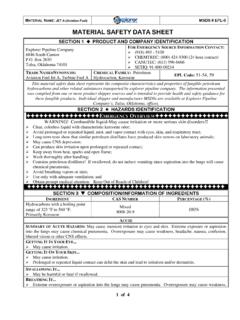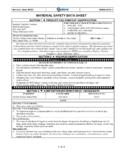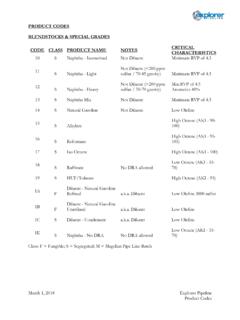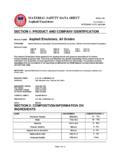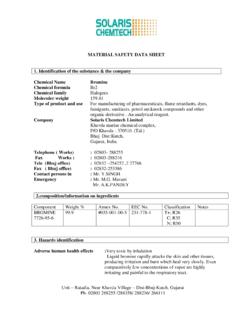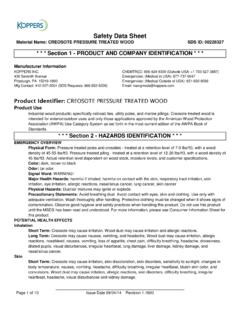Transcription of MATERIAL SAFETY DATA SHEET - Expl
1 MATERIAL NAME: Light cycle Oil MSDS # EPL-14 1 of 4 MATERIAL SAFETY data SHEET SECTION 1 X PRODUCT AND COMPANY IDENTIFICATION Explorer Pipeline Company 6846 South Canton Box 2650 Tulsa, Oklahoma 74101 FOR EMERGENCY SOURCE INFORMATION CONTACT: (918) 493 - 5100 CHEMTREC: (800) 424-9300 (24 hour contact) CANUTEC: (613) 996-6666 SETIQ: 91-800-00214 TRADE NAMES/SYNONYMS: Light Cat Cracked Distillate; Light Cat Gasoline CHEMICAL FAMILY: Petroleum Middle Distillate EPL Code: 80 This MATERIAL SAFETY data SHEET represents the composite characteristics and properties of fungible petroleum hydrocarbons and other related substances transported by explorer pipeline company.
2 The information presented was compiled from one or more product shipper sources and is intended to provide health and SAFETY guidance for these fungible products. Individual shipper and manufacturer MSDSs are available at Explorer Pipeline Company s, Tulsa, Oklahoma, offices. SECTION 2 ; HAZARDS IDENTIFICATION )))))))))))))))))EMERGENCY OVERVIEW)))))))))))))))))Warning Combustible Liquid!! Yellow liquid with kerosene odor; Harmful or fatal if swallowed, inhaled or absorbed through skin. May cause CNS depression. Can produce skin irritation upon prolonged or repeated contact.
3 Keep away from heat, sparks and open flame; Wash thoroughly after handling; Contains petroleum distillates! If swallowed, do not induce vomiting since aspiration into the lungs will cause chemical pneumonia; Avoid breathing vapors or mist; Use only with adequate ventilation; and Obtain prompt medical attention. Keep Out of Reach of Children! )))))))))))))))))))))))))))))))))))))))) )))))) SECTION 3 W COMPOSITION/INFORMATION OF INGREDIENTS INGREDIENT CAS NUMBER PERCENTAGE (%) Complex mixture of paraffinic, cycloparaffinic, olefinic, and aromatic hydrocarbons (predominately C9 - C25) produced by the distillation of products from a catalytic cracking process.
4 This stream is likely to contain a relatively large portion of bicyclical aromatic hydrocarbons. 64741-59-9 Varies ACUTE SUMMARY OF ACUTE HAZARDS: May cause transient irritation to eyes and skin. Extreme exposure or aspiration into the lungs may cause chemical pneumonia. Overexposure may cause weakness, headache, nausea, confusion, blurred vision or other CNS effects. GETTING IT IN YOUR May cause irritation. MATERIAL NAME: Light cycle Oil MSDS # EPL-14 2 of 4 GETTING IT ON YOUR May cause irritation.
5 Prolonged or repeated liquid contact can defat the skin and lead to irritation and/or dermatitis. SWALLOWING May be harmful or fatal if swallowed. BREATHING Extreme overexposure or aspiration into the lungs may cause pneumonia. Overexposure may cause weakness, headache, nausea, confusion, blurred vision, drowsiness, and other nervous system effects. CHRONIC Similar in nature to acute effects above. Chronic human health effects would not be expected as long as good personal hygiene and proper SAFETY precautions are practiced.
6 CANCER, REPRODUCTIVE AND GENETIC EFFECTS Some components of naphtha, , paraffins and olefins, have been shown to produce a species specific, sex hormonal dependent kidney lesion in male rats from repeated oral or inhalation exposure. The exact relationship between these results and human health is not known. See Toxicological Information (Section 11) For More Information SECTION 4 FIRST AID MEASURES EMERGENCY MEDICAL TREATMENT PROCEDURES: Activated charcoal slurry may be administered. To prepare activated charcoal slurry, suspend 50 grams activated charcoal in 400 mL water and mix thoroughly.
7 Administer 5mL/kg, or 350 mL for an average adult. EYES: In case of contact, immediately flush eyes with plenty of water for at least 15 minutes. Call a physician. SKIN: In case of contact, immediately wash skin with soap and water. Wash contaminated clothing before reuse. If irritation develops, consult a physician. INGESTION: If swallowed, do not induce vomiting. Immediately give two glasses of water. Never give anything by mouth to an unconscious person. Call a physician. INHALATION: If inhaled, remove to fresh air. If not breathing, give artificial respiration.
8 If breathing is difficult, give oxygen. Call a physician. NOTE TO PHYSICIAN: TREAT SYMPTOMATICALLY AND SUPPORTIVELY SECTION 5 a FIRE FIGHTING MEASURES Combustible Liquid. Products of combustion my contain carbon monoxide, carbon dioxide and other toxic materials. Do not enter enclosed or confined space without proper protective equipment including respiratory protection. FLASH POINT:(Method Used) 160 F FLAMMABLE LIMITS: LEL: No data UEL: No data AUTOIGNITION TEMPERATURE: No data EXTINGUISHING MEDIA: Fight fire with dry chemical, carbon dioxide, foam, water spray, or fog.
9 HAZARDOUS REACTIONS/DECOMPOSITION: MATERIAL is stable at 70 F and 760 mmHg. Incompatible with strong oxidizers. Carbon monoxide, carbon dioxide, aldehydes, aromatics, and other hydrocarbons. SPECIAL INSTRUCTIONS: Do not enter any enclosed or confined fire space without proper protective equipment. Wear full firefighting turn out gear and respirator (SCBA) operated in pressure demand or other positive pressure mode. SECTION 6 ACCIDENTAL RELEASE MEASURES Review FIRE AND EXPLOSION HAZARDS and SAFETY PRECAUTIONS before proceeding with clean up.
10 Use appropriate PERSONAL PROTECTIVE EQUIPMENT during clean up. Dike spill. Prevent liquid from entering sewers, waterways or low areas. Recover free liquid for reuse or reclamation. Soak up with sawdust, sand, oil dry or other absorbent MATERIAL . MATERIAL NAME: Light cycle Oil MSDS # EPL-14 3 of 4 Remove source of heat, sparks, flame, impact, friction, and electricity including internal combustion engines and power tools. If equipment is used for spill cleanup, it must be explosion-proof and suitable for flammable liquid and vapors.

